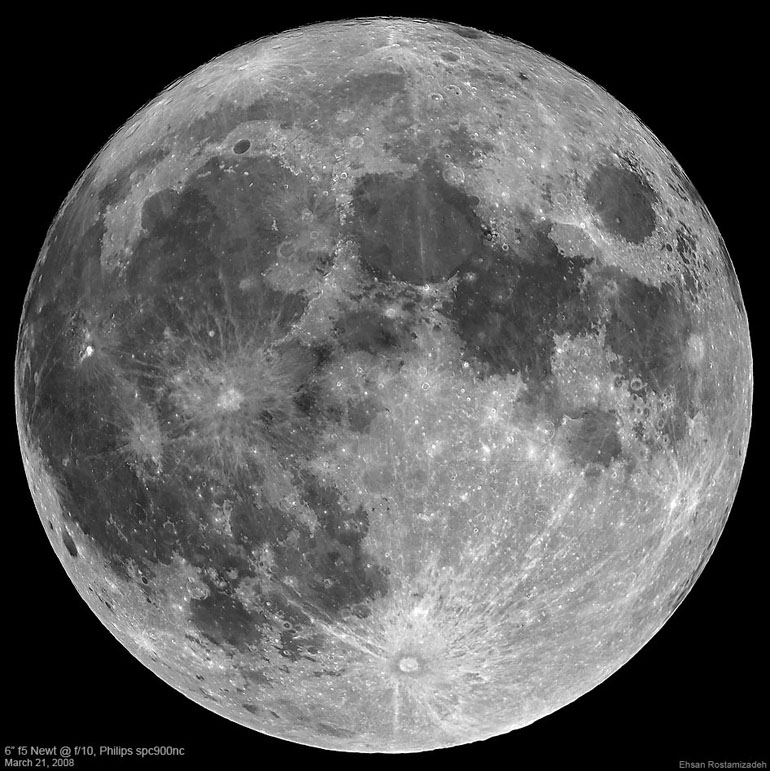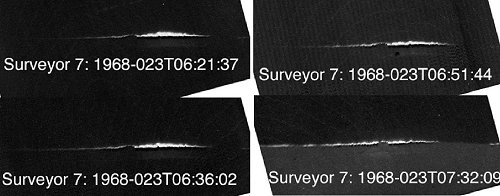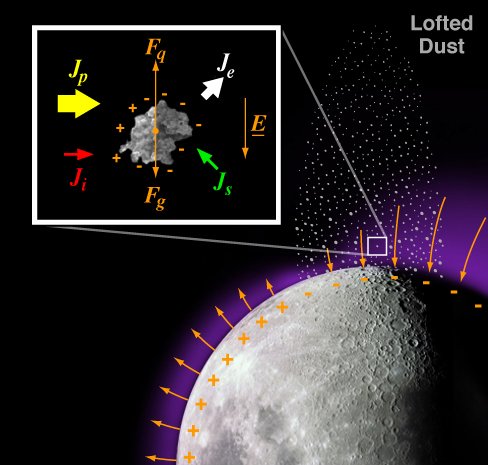|
Lunar Atmosphere |
|||
|
..
The Moon and the Magnetotail 04.17.2008 + Play Audio | + Download Audio April 17, 2008: Behold the full Moon. Ancient craters and frozen lava seas lie motionless under an airless sky of profound quiet. It's a slow-motion world where even a human footprint may last millions of years. Nothing ever seems to happen there. Right? Wrong. NASA-supported scientists have realized that something does happen every month when the Moon gets a lashing from Earth's magnetic tail. "Earth's magnetotail extends well beyond the orbit of the Moon and, once a month, the Moon orbits through it," says Tim Stubbs, a University of Maryland scientist working at the Goddard Space Flight Center. "This can have consequences ranging from lunar 'dust storms' to electrostatic discharges." Yes, Earth does have a magnetic tail. It is an extension of the same familiar magnetic field we experience when using a Boy Scout compass. Our entire planet is enveloped in a bubble of magnetism, which springs from a molten dynamo in Earth's core. Out in space, the solar wind presses against this bubble and stretches it, creating a long "magnetotail" in the downwind direction: diagram. Anyone can tell when the Moon is inside the magnetotail. Just look: "If the Moon is full, it is inside the magnetotail," says Stubbs. "The Moon enters the magnetotail three days before it is full and takes about six days to cross and exit on the other side." It is during those six days that strange things can happen.
During the crossing, the Moon comes in contact with a gigantic "plasma sheet" of hot charged particles trapped in the tail. The lightest and most mobile of these particles, electrons, pepper the Moon's surface and give the Moon a negative charge. On the Moon's dayside this effect is counteracted to a degree by sunlight: UV photons knock electrons back off the surface, keeping the build-up of charge at relatively low levels. But on the nightside, in the cold lunar dark, electrons accumulate and voltages can climb to hundreds or thousands of volts. Walking across the dusty charged-up lunar terrain, astronauts may find themselves crackling with electricity like a sock pulled out of a hot dryer. Touching another astronaut, a doorknob, a piece of sensitive electronics—any of these simple actions could produce an unwelcome zap. "Proper grounding is strongly recommended," advises Stubbs. The ground, meanwhile, may leap into the sky. There is compelling evidence (see, e.g., the Surveyor 7 image below) that fine particles of moondust, when sufficiently charged-up, actually float above the lunar surface. This could create a temporary nighttime atmosphere of dust ready to blacken spacesuits, clog machinery, scratch faceplates (moondust is very abrasive) and generally make life difficult for astronauts. Stranger still, moondust might gather itself into a sort of diaphanous wind. Drawn by differences in global charge accumulation, floating dust would naturally fly from the strongly-negative nightside to the weakly-negative dayside. This "dust storm" effect would be strongest at the Moon's terminator, the dividing line between day and night. Much of this is pure speculation, Stubbs cautions. No one can say for sure what happens on the Moon when the magnetotail hits, because no one has been there at the crucial time. "Apollo astronauts never landed on a full Moon and they never experienced the magnetotail." The best direct evidence comes from NASA's Lunar Prospector spacecraft, which orbited the Moon in 1998-99 and monitored many magnetotail crossings. During some crossings, the spacecraft sensed big changes in the lunar nightside voltage, jumping "typically from -200 V to -1000 V," says Jasper Halekas of UC Berkeley who has been studying the decade-old data.
In 1968, on many occasions, NASA's Surveyor 7 moon lander photographed a strange "horizon glow" after dark. Researchers now believe the glow is sunlight scattered from electrically-charged moondust floating just above the lunar surface. [Larger image] "It is important to note," says Halekas, "that the plasma sheet (where all the electrons come from) is a very dynamic structure. The plasma sheet is in a constant state of motion, flapping up and down all the time. So as the Moon orbits through the magnetotail, the plasma sheet can sweep across it over and over again. Depending on how dynamic things are, we can encounter the plasma sheet many times during a single pass through the magnetotail with encounters lasting anywhere from minutes to hours or even days." "As a result, you can imagine how dynamic the charging environment on the Moon is. The Moon can be just sitting there in a quiet region of the magnetotail and then suddenly all this hot plasma goes sweeping by causing the nightside potential to spike to a kilovolt. Then it drops back again just as quickly." The roller coaster of charge would be at its most dizzying during solar and geomagnetic storms. "That is a very dynamic time for the plasma sheet and we need to study what happens then," he says. What happens then? Next-generation astronauts are going to find out. NASA is returning to the Moon in the decades ahead and plans to establish an outpost for long-term lunar exploration. It turns out they'll be exploring the magnetotail, too. Author:
Dr. Tony Phillips
SOURCE: http://science.nasa.gov/headlines/y2008/17apr_magnetotail.htm?list920094 |
|||
| Solar Wind vs. Magnetotail: Earth's magnetotail isn't
the only source of plasma to charge the Moon. Solar wind can provide charged
particles, too; indeed, most of the time, the solar
wind is the primary source. But when the Moon enters the magnetotail,
the solar wind is pushed back and the plasma sheet takes over. The plasma
sheet is about 10 times hotter than the solar wind and that gives it more
"punch" when it comes to altering the charge balance of the Moon's surface.
Two million degree electrons in the plasma sheet race around like crazy
and many of them hit the Moon's surface. Solar wind electrons are relatively
cool at only 140 thousand degrees, and fewer of them zip all the way down
to the shadowed surface of the Moon's nightside.
..
Electrostatic forces acting on moondust may cause the dust to float off the Moon's surface. Credit: Tim Stubbs/U. Maryland/GSFC. [Larger image] Moon Fountains -- (Science@NASA) When astronauts return to the Moon, they might encounter electrified fountains and other strange things. Moondust in the Wind -- (Science@NASA) What happens when moondust is exposed to solar wind? NASA scientists have found some surprising answers. Moon Storms -- (Science@NASA) An old Apollo experiment is telling researchers something new and surprising about the moon. The Mysterious Smell of Moondust -- (Science@NASA) Decades after the Apollo program, scientists are still trying to figure out why moondust smells like gunpowder. NASA's Future: US Space Exploration Policy |
|||
| FAIR USE NOTICE: This page contains copyrighted material the use of which has not been specifically authorized by the copyright owner. Pegasus Research Consortium distributes this material without profit to those who have expressed a prior interest in receiving the included information for research and educational purposes. We believe this constitutes a fair use of any such copyrighted material as provided for in 17 U.S.C § 107. If you wish to use copyrighted material from this site for purposes of your own that go beyond fair use, you must obtain permission from the copyright owner. | |||
|
|




